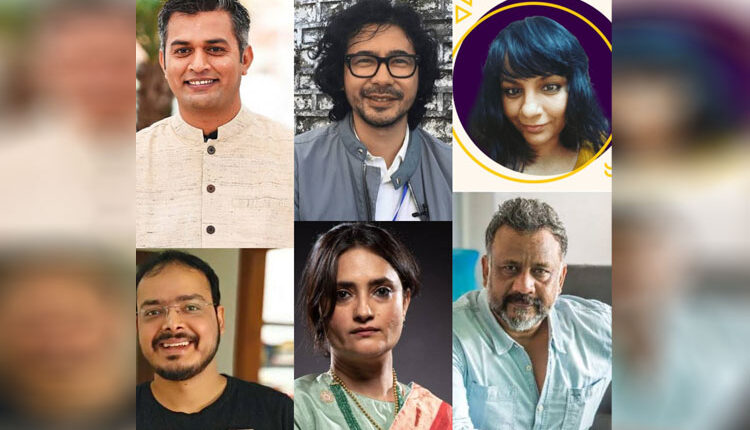Meet the story-tellers who are pushing Indian cinema out of its comfort zone

Contents
Formulaic story-telling is becoming increasingly obsolete with the proliferation of OTT platforms and the arrival of a new generation of filmmakers and writers who are confronting issues like casteism, racism, inequality and gender suppression with their work. Here is our pick of the trailblazers.
Neeraj Ghaywan (Geeli Pucchi):
With Masaan, Juice (a short) and Geeli Pucchi,writer-director Neeraj Ghaywan has become the teller of truths that remain buried under layers of glitzy entertainment in cinema. Be it the intercaste love story or the brutal moral policing in Masaan (written by Varun Grover), the silent rebellion of a home-maker in Juice (co-written by Ghaywan, Ranjan Chandel and Suraj Majhi) or a queer, Dalit blue-collar worker Bharti’s triumph over a rigged system in Geeli Pucchi (part of Dharma Production’s anthology, Ajeeb Daastaans for Netflix), he has repeatedly created narratives to make invisible discrimination, visible to us. So that we can never pretend that we live in a world without casteism, patriarchy and social inequalities. His stories do not have sloganeering or long dialogues but clarity and conviction so that we can instantly recognise similar characters and situations around us.
Nicholas Kharkongor (Axone):
Nicholas Kharkongor tells a story in the Yoodlee production Axone, that has never made it to cinematic mainstream. The story of a north-eastern boy who is beaten up by a mob in Delhi for his blonde hair. Of a young woman who is slapped when she calls out an eve-teaser. Of tenants who cannot cook what they want because their food emits unfamiliar smells. The judgmental, curious gaze of the nation’s capital follows the largely north-eastern ensemble cast of Axone and makes us aware of what our fellow citizens go through on a daily basis. This is a story that does not judge the people who judge and discriminate. It just shows them a mirror. Nicholas Kharkongor reminds us that just because some stories are never told, doesn’t mean they do not exist. He also ends the story on an uplifting note because perhaps he wants to convey that change is possible if enough people want it.
Anvita Dutt (Bulbbul):
Produced by Anushka Sharma’s Clean Slate Filmz, this Anvita Dutt tour de force for Netflix strips the romance away from child marriages that cinema has celebrated in films like Balika Badhu and shows us what happens to vulnerable young girls when they are just treated as commodities to be used and destroyed. Only in Bulbbul, the script is tweaked and a story about oppression becomes a celebration of unapologetic feminine power. The film spares no punches as it shows us the suffering of the protagonist where violence is unleashed against both her body and spirit. As a supernatural twist turns the whole story on its head, we are forced to ask ourselves, why must women always be looked at either as victims or witches?
Smita Singh (Raat Akeli Hai):
This Honey Trehan directorial was produced by Abhishek Chaubey and Ronnie Screwvala for Netflix. Written by Smita Singh, the film immediately plunges us in the heart of a divided family where dark secrets lurk just under the surface and murder is just a trigger away. The film touches upon the obsession with skin colour that afflicts the ‘marriage market,’ the abuse that takes place within families but is never addressed and how patriarchy creates unequal marriages. In the guise of a whodunit, Smita layers the narrative with multiple conversations about corruption, violence and gender bias through characters that are both victims and perpetrators of crimes and prejudices. Smita once said that the film’s script was an example of ‘termite art’, a term coined by artist and film critic Manny Farber to describe projects that “quietly chew on the boundaries of what is acceptable and not.”
Anubhav Sinha and Gaurav Solanki (Article 15):
The Hathras case and countless instances of atrocities against Dalit women make it to the headlines occasionally but do not occupy media spaces long enough to spark grassroots change. Despite the criticism it has garnered over what many critics called a ‘saviour complex’, Anubhav Sinha’s directorial Article 15 is an important attempt to show us what the headlines can’t. Inspired by the now-forgotten Badaun rape case, the film unsparingly depicts systemic discrimination and caste-based cruelties that take place every day. The film despite its flaws at least initiates a conversation that commercial Hindi cinema has steered clear of except for a few exceptions like JP Dutta’s Ghulami. This film that came after Mulk is part of Sinha’s self-discovery as a maker with a purpose. He also sought out well-known writer Gaurav Solanki to co-write Article 15 with him and together they reminded us that the Constitutional right to equality is not available to everyone.
Stay tuned with Gossipganj for latest updates and don’t forget to share this article with your friends and follow us on Twitter.
